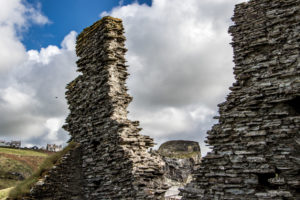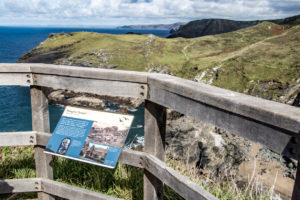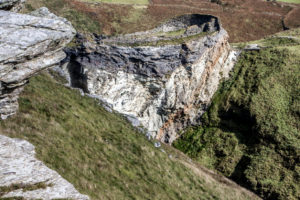Tintagel Castle is a medieval fortification located on the peninsula of Tintagel Island adjacent to the village of Tintagel, North Cornwall. The site was possibly occupied in the Romano-British period, as an array of artefacts dating from this period have been found on the peninsula, but as yet no Roman-era structure has been proven to have existed there. It was settled during the early medieval period, when it was probably one of the seasonal residences of the regional king of Dumnonia. A castle was built on the site by Richard, 1st Earl of Cornwall in the 13th century, during the High Middle Ages. It later fell into disrepair and ruin.
The castle has a long association with legends related to King Arthur. This was first recorded in the 12th century when Geoffrey of Monmouth described Tintagel as the place of Arthur’s conception in his mythological account of British history, Historia Regum Britanniae. Geoffrey told the story that Arthur’s father, King Uther Pendragon, was disguised by Merlin’s sorcery to look like Gorlois, Duke of Cornwall, the husband of Igraine, Arthur’s mother.
Romano-British period
In the 1st century AD, southern Britain was invaded and occupied by the Roman Empire. The territory of modern Cornwall was assigned to the Roman administrative region of civitas Dumnoniorum, named after the local British tribal group whom the Romans called the Dumnonii. At the time, this south-westerly point of Britain was “remote, under-populated and therefore also unimportant [to the Roman authorities] until, during the 3rd century AD, the local tin-streaming industry attracted attention.” Archaeologists know of five milestones or route-markers in Cornwall erected in the Romano-British period. Two of these are in the vicinity of Tintagel, indicating that a road passed through the locality.
Early medieval period
Roman control collapsed in southern Britain following the fall of the Western Roman Empire in the early 5th century and it split into various different kingdoms, each with its own respective chief or king. The former Roman district of civitas Dumnoniorum apparently became the Kingdom of Dumnonia, which would have been ruled over by its own monarchy during this early medieval period between the 5th and 8th centuries.
Arthurian legends
The castle has a long association with the Arthurian legends, being first associated with King Arthur by Welshman Geoffrey of Monmouth in his book the Historia Regum Britanniae (“History of the Kings of Britain'”), written circa 1135–38, which includes a detailed account of the legend. According to Geoffrey and the legend, Arthur’s father was Uther Pendragon, the king of all Britain. He goes to war against Gorlois, the Duke of Cornwall, to capture Gorlois’s wife Igraine, with whom Uther has fallen in love. Gorlois defends himself against Uther’s armies at his fort of Dimilioc, but he sends Igraine to stay safely within Tintagel Castle which is his most secure refuge, according to the legend and the Historia Regum Britanniae. Uther besieges Dimilioc, telling his friend Ulfin how he loves Igraine, but Ulfin replies that it would be impossible to take Tintagel, for “it is right by the sea, and surrounded by the sea on all sides; and there is no other way into it, except that provided by a narrow rocky passage—and there, three armed warriors could forbid all entry, even if you took up your stand with the whole of Britain behind you.” Geoffrey of Monmouth’s story goes on to explain how the wizard Merlin is summoned and magically changes Uther’s appearance to that of Gorlois to help get them into Tintagel Castle, while also changing his own and Ulfin’s appearances to those of two of Gorlois’s companions. Disguised thus, they are able to enter Tintagel where Uther goes to Igraine, and “in that night was the most famous of men, Arthur, conceived.”
Tintagel is used as a locus for the Arthurian mythos by the poet Alfred, Lord Tennyson in the poem Idylls of the King. Letitia Elizabeth Landon’s poem A Legend of Tintagel Castle (1832) is another variation on the story of Lancelot and Elaine. Algernon Charles Swinburne’s Tristram of Lyonesse is a literary version of the Tristan and Iseult legend in which some events are set at Tintagel. Thomas Hardy’s The Famous Tragedy of the Queen of Cornwall at Tintagel in Lyonnesse, a one-act play which was published in 1923, is another version of the same legend with events set at Tintagel.












